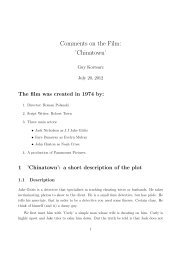Nuclear Magnetic Resonance (NMR) Spectroscopy
Nuclear Magnetic Resonance (NMR) Spectroscopy
Nuclear Magnetic Resonance (NMR) Spectroscopy
You also want an ePaper? Increase the reach of your titles
YUMPU automatically turns print PDFs into web optimized ePapers that Google loves.
<strong>Nuclear</strong> <strong>Magnetic</strong> <strong>Resonance</strong> (<strong>NMR</strong>) <strong>Spectroscopy</strong><br />
<strong>NMR</strong> is the most powerful analytical tool currently available to an organic<br />
chemist.<br />
<strong>NMR</strong> allows characterization of a very small amount of sample (10mg), and<br />
does not destroy the sample (non-destructive technique).<br />
<strong>NMR</strong> spectra can provide vast information about a molecule's structure and<br />
can very often be the only way to prove what the compound really is.<br />
Typically though, <strong>NMR</strong> is used in conjunction with other types of<br />
spectroscopy and chemical analysis to fully confirm a complicated<br />
molecule's structure.<br />
<strong>NMR</strong> Theory<br />
Any nucleus that has either an odd atomic number or an odd mass number<br />
has a nuclear spin that can be observed by an <strong>NMR</strong> spectrometer.<br />
The proton is the simplest odd numbered atomic nucleus (and also the most<br />
useful for organic characterization).<br />
<strong>NMR</strong> theory is reasonably complicated, involving the magnetic alignment of<br />
spins of different nuclei.<br />
More important is the use of <strong>NMR</strong> to elucidate structures.<br />
<strong>NMR</strong> spectroscopy important facts:<br />
(1) The number of different absorptions implies how many different types<br />
of hydrogens are present.<br />
(2) The amount of shielding (chemical shift) is determined by each<br />
hydrogen's environment, and so we get information about the local<br />
electronic surroundings for each hydrogen.<br />
(3) The intensities of the signals tell us the number of identical<br />
hydrogens.<br />
(4) The splittings of each signal tells us about the other groups proximate<br />
to the hydrogens in question.<br />
Ch13 <strong>NMR</strong> Page1
A Simple <strong>NMR</strong> Machine<br />
An <strong>NMR</strong> machine consists of:<br />
(1) A powerful, supercooled magnet (stable, with sensitive control,<br />
producing a precise magnetic field).<br />
(2) A radio-frequency transmitter (emitting a very precise frequency).<br />
(3) A detector to measure the absorption of radiofrequency by the sample.<br />
(4) A recorder (to plot the output).<br />
Figure 13-6(SLIDE)<br />
A simple <strong>NMR</strong> spectrum plots absorption on the y axis, and magnetic field<br />
strength on the x axis (Scale is in parts per million, and usually goes from 0-<br />
10 ppm).<br />
The different positions of <strong>NMR</strong> absorptions are described as chemical shifts<br />
(δ).<br />
A chemical shift is defined as the difference in parts per million (ppm)<br />
between the resonance frequency of the observed proton and that of the<br />
tetramethylsilane (TMS) hydrogens.<br />
TMS is the most common reference compound in <strong>NMR</strong>, it is set at δ=0ppm.<br />
The chemical shift in ppm is calculated as the shift downfield from TMS in<br />
Hz, divided by the spectrometer operating frequency in MHz.<br />
So if a 60MHz spectrometer records a proton resonance at a frequency of<br />
426Hz downfield from TMS, this corresponds to a chemical shift of 426/60<br />
= 7.10ppm.<br />
Figure 13-9(SLIDE)<br />
Ch13 <strong>NMR</strong> Page2
New 300MHz <strong>NMR</strong> Machine<br />
Ch13 <strong>NMR</strong> Page3
Ch13 <strong>NMR</strong> Page4
The <strong>NMR</strong> spectrum of methanol shows only two resonances (and the<br />
reference TMS peak at 0ppm).<br />
The hydrogens in the CH3 group are all the same → 1 resonance<br />
The OH proton gives a signal at different δ.<br />
We can say that there are two chemically different hydrogens in methanol.<br />
Different hydrogens absorb at different chemical shifts - see table 13-3 and<br />
Figure 13-40<br />
(SLIDE)<br />
<strong>NMR</strong> of Acetic Acid<br />
Figure 13-15 (SLIDE)<br />
The number of signals tells us the number of chemically equivalent<br />
hydrogens in a molecule.<br />
E.g. the <strong>NMR</strong> of methyl t butylether Figure 13-19. (SLIDE)<br />
There are two types of chemically equivalent hydrogens → 2 separate<br />
resonances in the <strong>NMR</strong> spectrum.<br />
The <strong>NMR</strong> of methylacetoacetate (Figure 13-17) shows 3 different proton<br />
resonances. (SLIDE)<br />
Areas under the Peaks<br />
<strong>NMR</strong> machines are equipped with integrators, which can calculate the area<br />
under each peak in the <strong>NMR</strong> spectrum.<br />
This is very useful since the area under a peak is equivalent to the number of<br />
identical hydrogens that contribute to that signal.<br />
Figure 13-9 and Figure 13-20 (SLIDES)<br />
Ch13 <strong>NMR</strong> Page5
Remember that this only gives the RATIO of the number of hydrogen, so a<br />
ratio of 1 : 2 : 3 is the same as a ratio of 2 : 4 : 6 and 0.5 : 1 : 1.5<br />
This is where 'simple' <strong>NMR</strong> ends…<br />
Ch13 <strong>NMR</strong> Page6





